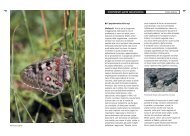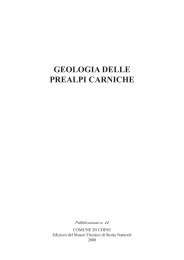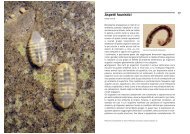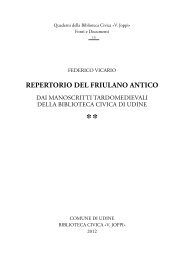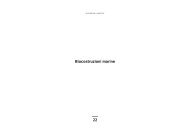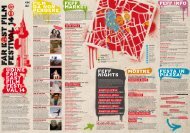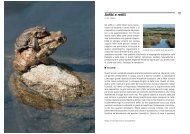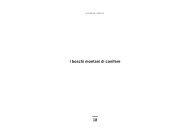Despite its inhospitable appearance and lack of any ... - Udine Cultura
Despite its inhospitable appearance and lack of any ... - Udine Cultura
Despite its inhospitable appearance and lack of any ... - Udine Cultura
You also want an ePaper? Increase the reach of your titles
YUMPU automatically turns print PDFs into web optimized ePapers that Google loves.
108 109<br />
Stygodiversity in the Presciano springs: a pilot experiment<br />
Diana Maria Paola Galassi · Barbara Fiasca<br />
The Presciano springs make up one <strong>of</strong><br />
the three great sources giving rise to the<br />
river Tirino in Abruzzi, at the foot <strong>of</strong> the<br />
greatest karstic aquifer in the<br />
Apennines. They have proved to be<br />
excellent natural laboratories for<br />
scientific research on the environmental<br />
factors affecting the spatial distribution<br />
<strong>of</strong> groundwater species (the spring area<br />
does not exceed 2000 m 2).<br />
This spring system is structurally<br />
complex, as a heterogeneous alluvial<br />
layer lies on strongly karstified bedrock,<br />
covering the underlying karstic aquifer.<br />
This situation has enabled researchers<br />
to examine how the different types <strong>of</strong><br />
sediments affect the composition <strong>of</strong><br />
underground communities.<br />
Detailed samplings have revealed that<br />
stygoxenic, stygophilic <strong>and</strong> stygobiont<br />
species are not at all homogenously<br />
distributed in the small spring area<br />
Presciano springs (Abruzzi)<br />
As depth increases, the relative<br />
importance <strong>of</strong> stygobionts increases to<br />
the detriment <strong>of</strong> other ecological<br />
categories, while stygophiles are<br />
generally found at intermediate depths<br />
(at 30 <strong>and</strong> 70 cm below the spring bed).<br />
This vertical distribution is a direct<br />
consequence <strong>of</strong> the ecological<br />
characteristics <strong>of</strong> stygobionts, which are<br />
morphologically <strong>and</strong> physiologically<br />
adapted to life in deep habitats, <strong>and</strong> <strong>of</strong><br />
stygophiles, a transitional category that<br />
clearly prefers ecotonal areas.<br />
Stygoxenes are scattered, especially in<br />
subsurface sites, perhaps restricted by<br />
the low temperatures <strong>and</strong> oligotrophic<br />
conditions <strong>of</strong> the spring environment.<br />
Further analysis, carried out by<br />
dividing fauna living in karstic sites from<br />
that <strong>of</strong> alluvial sites, shows that<br />
stygophiles are almost exclusively<br />
found in the latter habitat.<br />
In addition, alluvial sites characterized<br />
by heterogeneous grain-size<br />
composition, with clearly alternating<br />
temporal upwelling <strong>and</strong> downwelling<br />
phases, host greater biodiversity, as<br />
they provide more ecological niches<br />
than karstic sites, <strong>and</strong> contain greater<br />
quantities <strong>of</strong> organic matter, which is<br />
trapped in interstices.<br />
Copepod taxocoenoses, the most<br />
important group in the analysed springs,<br />
are found in alluvial sites, with 15 out <strong>of</strong><br />
the 17 species collected in the entire<br />
spring system. Instead, karstic sites<br />
host more monotonous karstic fauna,<br />
with one harpacticoid copepod<br />
(Nitocrella pescei) making up 90% <strong>of</strong><br />
the entire assemblage. However, it is<br />
precisely in karstic sites that we find the<br />
most biogeographically interesting<br />
species, Pseudectinosoma reductum, a<br />
relict <strong>of</strong> ancient marine origin.<br />
Nitocrella pescei<br />
Distribution <strong>of</strong> ecological categories (number <strong>of</strong><br />
specimens) at various depths (in cm)




